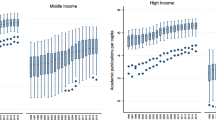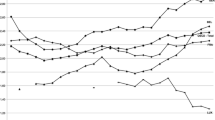Summary
In 1985 China began the reform of its Science & Technology (S&T) sector inherited from the planned economy. To disclose the impact of the drawn-out reform on the efficiency of the whole sector, we measure the scientific productivity of China's S&T institutes. The analysis is based on R&D input and output data at the country aggregate and provincial level. We utilize Polynomial Distributed Lag model to uncover the structure of the lag between R&D input and output. The findings reveal that the growth rate of scientific productivity of China's S&T institutes has been negative since the 1990s.
Similar content being viewed by others
Author information
Authors and Affiliations
Rights and permissions
About this article
Cite this article
Huang, C., Varum, C. & Gouveia, J. Scientific productivity paradox: The case of China's S&T system. Scientometrics 69, 449–473 (2006). https://doi.org/10.1007/s11192-006-0153-6
Issue Date:
DOI: https://doi.org/10.1007/s11192-006-0153-6




